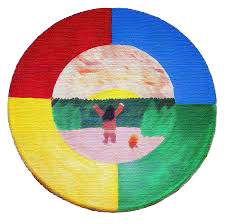Looking Down The Road To The Past
Helen McPhaden and I met this summer to discuss creating a new performance piece with the girls, for them to perform at various locations around Calgary as we have done in the past with Committing and The Make Believer Project.
The timing of our meeting was just after the Commission on Missing and Murdered Aboriginal Women had released its report, so that was certainly on our minds when we sat down to discuss a new project.
As we all know, sadly, one important element of the whole messed up situation is the Highway of Tears in British Columbia. The big question for Helen and me is what exactly do the Stardale girls make of that situation? How does it make them feel? What would they have to say about it that I could help shape into a performance piece?
The tricky part is, it's a very delicate subject and you have to be sensitive to the girls and find a way to talk about such painful realities in a way that won't leave them traumatized. You need to create a larger platform for the story to be told in, to provide a larger context, so in that regard we settled on the idea of The Road, used as it often is as a metaphor for life, which may at some point encompass the Highway of Tears.
With this wider focus, we hope to be able to explore the girls' sense of history of their people - where they came from, how they lived, problems they have faced; then the present - what is the road (or city street) they now find themselves on like; and then the future - what kind of road do they envision for themselves as they grow older, and for their children and grandchildren.
Here's the thing that I hadn't thought about when we began this, and I suppose a reality that is generational. Because I grew up in the pre-digital world, I can envision a time when things were very different than they are now. I'm what's known as a digital immigrant.
Not so for the girls. They are digital natives, so to speak. They don't really know any other way of life or of interacting with the world around them. So, I asked them to imagine a world that has none of the things that we take for granted. Take away the building we were working in, and with-it electricity and heat and plumbing and the chairs we were sitting on and everything else.
This they could do, by and large. But then I asked them what they would do, how they would occupy their time in this natural world, and that became a little more difficult to envision. No smart phones, no tablets, no iTunes or Spotify, no Netflix, no Facebook, no Instagram, no Snapchat - none of what we all take for granted now and spend most of our time engaged with. What then?
There were a lot of blanks drawn on that one. Suddenly the world seemed like a big vacuum with nothing in it. Nothing they were used to, nothing that mattered to them, nothing they could really talk about. It's probably an interesting exercise for anyone these days: how would you spend your time without and of these things we are all now so terribly addicted to?
So, little by little we will creep forward in time. When I think they are ready to learn more about the Highway of Tears and share their feelings about it, we will go there, and it will be an important part of our journey down the road and an important element of our performance piece.
Of course, in creating a piece like this, it's all about the journey, after all.


